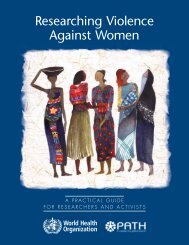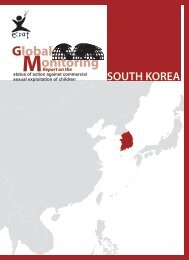2007 Trafficking in Persons Report - Center for Women Policy Studies
2007 Trafficking in Persons Report - Center for Women Policy Studies
2007 Trafficking in Persons Report - Center for Women Policy Studies
Create successful ePaper yourself
Turn your PDF publications into a flip-book with our unique Google optimized e-Paper software.
seek employment and work permits. S<strong>in</strong>gaporean<br />
authorities refer victims of traffick<strong>in</strong>g to shelters run<br />
by NGOs or <strong>for</strong>eign embassies. The MCYS <strong>in</strong> 2006<br />
encouraged one organization to submit a proposal<br />
to establish a shelter and agreed that the government<br />
would provide the facility. The MOM runs a<br />
hotl<strong>in</strong>e <strong>for</strong> domestic workers.<br />
Prevention<br />
The S<strong>in</strong>gaporean government <strong>in</strong>creased ef<strong>for</strong>ts to<br />
raise awareness among <strong>for</strong>eign workers and employers<br />
<strong>in</strong> 2006. The MOM cont<strong>in</strong>ued and expanded its<br />
<strong>in</strong><strong>for</strong>mation campaign that targets <strong>for</strong>eign workers,<br />
<strong>in</strong>clud<strong>in</strong>g domestics, to <strong>in</strong><strong>for</strong>m them of their rights<br />
and the resources available to them. The MOM pr<strong>in</strong>ts<br />
<strong>in</strong><strong>for</strong>mation on employees’ rights and police hotl<strong>in</strong>e<br />
numbers <strong>for</strong> domestic workers on prepaid phone<br />
cards and <strong>in</strong> October 2006 started a newsletter that<br />
is mailed directly to <strong>for</strong>eign domestic workers that<br />
<strong>in</strong>cludes <strong>in</strong><strong>for</strong>mation on rights and responsibilities.<br />
The MOM also distributes an <strong>in</strong><strong>for</strong>mation booklet<br />
to employers of <strong>for</strong>eign domestic workers that<br />
expla<strong>in</strong>s their rights and crim<strong>in</strong>al penalties that may<br />
be and have been applied aga<strong>in</strong>st employers who<br />
abuse their domestic servants. In November 2006,<br />
MOM launched a program of randomly <strong>in</strong>terview<strong>in</strong>g<br />
<strong>for</strong>eign domestic workers work<strong>in</strong>g <strong>in</strong> S<strong>in</strong>gapore <strong>for</strong><br />
the first time. The <strong>in</strong>terviews enable MOM to determ<strong>in</strong>e<br />
how well they have adjusted to their work<strong>in</strong>g<br />
conditions and to re<strong>in</strong><strong>for</strong>ce workers’ knowledge of<br />
their rights, responsibilities, and work place safety.<br />
S<strong>in</strong>gapore has not ratified the 2000 UN TIP Protocol.<br />
SLOVAK REPUBLIC (Tier 2)<br />
The Slovak Republic is a source country <strong>for</strong> women<br />
and girls trafficked to Germany, Austria, the Czech<br />
Republic, and Slovenia <strong>for</strong> the purpose of commercial<br />
sexual exploitation. It is also a transit country<br />
<strong>for</strong> women from Moldova, Ukra<strong>in</strong>e, Bulgaria,<br />
the Balkans, the Baltics, and People’s Republic of<br />
Ch<strong>in</strong>a trafficked to the Czech Republic, Germany,<br />
Switzerland, France, Italy, Austria, the Netherlands,<br />
the United K<strong>in</strong>gdom, Spa<strong>in</strong>, Croatia, and Slovenia<br />
<strong>for</strong> sexual exploitation. Roma women and girls<br />
with<strong>in</strong> Slovakia cont<strong>in</strong>ue to be highly vulnerable to<br />
traffick<strong>in</strong>g.<br />
The Government of the Slovak Republic does not<br />
fully comply with the m<strong>in</strong>imum standards <strong>for</strong> the<br />
elim<strong>in</strong>ation of traffick<strong>in</strong>g; however, it is mak<strong>in</strong>g<br />
significant ef<strong>for</strong>ts to do so. Although some ef<strong>for</strong>ts<br />
to implement Slovakia’s National Action Plan were<br />
stalled <strong>in</strong> 2006 with the temporary vacancy and<br />
reorganization of the National Anti-<strong>Traffick<strong>in</strong>g</strong><br />
Coord<strong>in</strong>ator’s position, Slovakia demonstrated<br />
important progress. In December 2006, the Slovak<br />
parliament passed a law allow<strong>in</strong>g <strong>for</strong> a renewable<br />
40-day stay <strong>for</strong> <strong>for</strong>eign victims. The government<br />
also signed cooperation agreements with three<br />
NGOs <strong>for</strong> a one-year pilot project to identify and<br />
provide shelter to victims. The government should<br />
ensure that police, customs officials, prosecutors,<br />
and social workers at refugee camps and asylum<br />
centers receive traffick<strong>in</strong>g-specific tra<strong>in</strong><strong>in</strong>g. The<br />
government should also collaborate with NGOs <strong>in</strong><br />
identify<strong>in</strong>g victims among persons <strong>in</strong> police detention<br />
centers and immigration facilities.<br />
Prosecution<br />
The Government of the Slovak Republic demonstrated<br />
progress <strong>in</strong> its law en<strong>for</strong>cement ef<strong>for</strong>ts dur<strong>in</strong>g<br />
the report<strong>in</strong>g period. The Slovak Republic prohibits<br />
all <strong>for</strong>ms of traffick<strong>in</strong>g through Sections 179-181 of<br />
its crim<strong>in</strong>al code, which prescribes penalties rang<strong>in</strong>g<br />
from four to 25 years’ imprisonment. These penalties<br />
are sufficiently str<strong>in</strong>gent and are commensurate<br />
with those prescribed <strong>for</strong> other grave crimes, such as<br />
rape. Police conducted 20 traffick<strong>in</strong>g <strong>in</strong>vestigations<br />
<strong>in</strong> 2006. The government prosecuted 32 traffick<strong>in</strong>g<br />
cases, compared to 30 cases <strong>in</strong> 2005. Convictions<br />
were obta<strong>in</strong>ed aga<strong>in</strong>st 18 traffickers <strong>in</strong> 2006, a<br />
significant <strong>in</strong>crease from four convictions <strong>in</strong> 2005.<br />
Most convicted traffickers were given sentences rang<strong>in</strong>g<br />
from three to five years’ imprisonment. However,<br />
two traffickers received suspended sentences and one<br />
trafficker was sentenced to 18 months’ imprisonment.<br />
There were no reported cases of government<br />
officials <strong>in</strong>volved <strong>in</strong> traffick<strong>in</strong>g. Dur<strong>in</strong>g the report<strong>in</strong>g<br />
period, police worked with NGOs to receive tra<strong>in</strong><strong>in</strong>g<br />
on victim identification and assistance.<br />
Protection<br />
The government demonstrated modest progress <strong>in</strong><br />
its victim protection ef<strong>for</strong>ts dur<strong>in</strong>g the report<strong>in</strong>g<br />
period. The government provided money to several<br />
NGOs <strong>for</strong> victim services and it assisted NGOs and<br />
IOM to locate temporary shelter and provide health<br />
services <strong>for</strong> approximately 10 victims it identified.<br />
Approximately 50 additional victims were assisted<br />
by NGOs and IOM. Police provided <strong>in</strong><strong>for</strong>mation to<br />
potential victims about NGO-provided services and<br />
the police anti-traffick<strong>in</strong>g unit implemented procedures<br />
to identify and refer victims to protection<br />
services. However, some authorities lack the tra<strong>in</strong><strong>in</strong>g<br />
to identify victims and expect victims to identify<br />
themselves. Victims are encouraged to participate<br />
<strong>in</strong> <strong>in</strong>vestigations and prosecutions. There were<br />
reports that unidentified victims were penalized or<br />
deported; NGOs were rarely given access to identify<br />
potential victims among deta<strong>in</strong>ed women held <strong>in</strong><br />
police or immigration detention centers.<br />
S L O V A K R E P U B L I C<br />
183
















